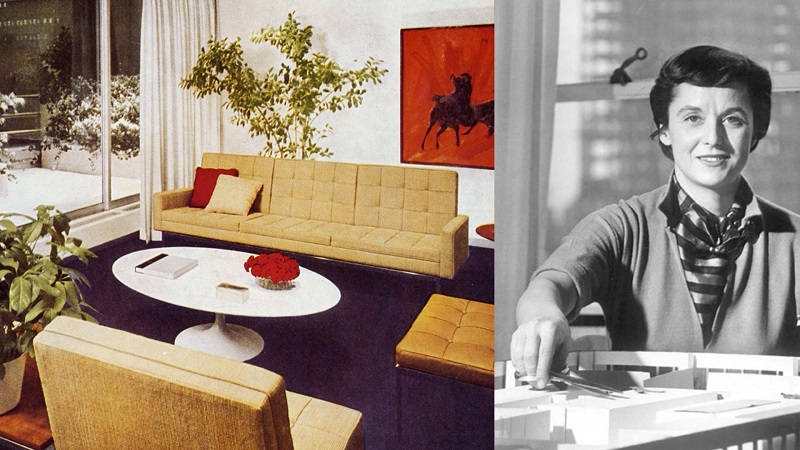ISABEL RUBIO ARROYO | Tungsteno
Behind the sleek, modern look of post-war corporate offices in the United States is a great woman: Florence Knoll, one of the most influential architects in the development of 20th century interior design. We explore the fascinating story of this American whose iconic designs are still commonplace in offices, homes, public spaces and museum collections.
"The fill-in pieces no one else was doing"
Despite being one of the most important furniture designers of her time, she said she never sat down to design furniture: "I designed the fill-in pieces that no one else was doing." By 1950 she had designed more than a third of the 63 products on the Knoll Associates price list. Among her creations is the Lounge Collection, designed in 1954. Her pieces, characterised by clean lines and geometric shapes, are poised on elegant metal frames.
Knoll's designs are frequently featured in international publications and are still available today. In a 1998 article, Vogue praised the Florence Knoll sofa and its transcendence from the confines of a "midtown Manhattan bank president's office with beige wall-to-wall carpeting" to "high-profile" settings such as fashion designer Tom Ford's apartment.
In 1964, The New York Times described Knoll as "the single most powerful figure in the field of modern design." The architect played a pivotal role in transforming Knoll Associates into the largest and most prestigious high-end design firm of its time. She also redefined office design with her innovative concept of "total design." Instead of traditional private offices, she proposed open-plan workspaces that facilitated collaboration and communication.
Knoll is credited with revolutionising modern office design. Credit: Casa Palacio
A new design for offices
"Once upon a time, virtually every big business executive thought his office had to have pale green walls and that his heavy desk with drawers to the floor had to be placed cater-corner [diagonally]," wrote The New York Times 60 years ago. That was until Knoll ushered in an era by proving that an office could be designed rather than decorated.
"I'm not a decorator. The only place I decorate is my own house," she said in an interview with the same newspaper. Knoll opted for vibrant colours and the iconic "Tulip chairs", which offered comfort and style. Chrome-legged desks and oval meeting tables reflected a modern, functional aesthetic. In multi-level interiors, she opted for open-riser staircases that seemed to float in the air.
She also popularised the idea of bringing art into the office. "Knoll was one of the few furniture companies in the United States to showcase contemporary art alongside Modern furniture in its showrooms, creating visual dialogues between unique works of art and mass-produced designs, an affirmation of the company's commitment to Modernism," explains architecture and design magazine Metropolis.
Knoll paid meticulous attention to every detail of the furniture. Credit: Knoll
From wire chair to 'Womb' chair
The architect became a full partner in Knoll Associates after marrying German-born furniture make Hans Knoll in 1946. After her husband's death in a car accident in 1955, she took over as president of the company. She sold her stake in the company in 1960, but continued as design director another five years. During this time, the company became one of the most influential design organisations.
In addition to her leadership, Knoll was also known for nurturing the careers of some of the most celebrated design names of the post-war era. For example, she supported sculptor Harry Bertoia during his two-year research into how to make furniture out of metal. This led to the iconic wire chairs, now regarded as Knoll classics. She asked Eero Saarinen to design a chair "like a great big basket of pillows" that you could curl up in. The result was the Womb chair, which seems to embrace the body.
Knoll died in 2019. Her legacy is reflected not only in her work, but also in the many awards she received. In 1961, she became the first woman to receive the Gold Medal for Industrial Design from the American Institute of Architects. Decades later, in 2003, then US President George W. Bush awarded her the National Medal of Arts, one of the country's highest honours for artistic excellence. The reason: an invaluable legacy in the world of design.
Tungsteno is a journalism laboratory to scan the essence of innovation.
